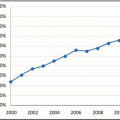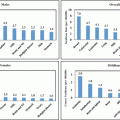Indicator
Between 1960–1970
Between 1990–2000
Current
2015
Under 5 mortality
227
128
89
52
Infant mortality
145
105
74
40
Maternal mortality
600
340
300–340
104
It would be logical and prudent to have an idea of the health system of Pakistan, before discussing the state of cancer care in our country. Federal government has a “stewardship” role as far as health system is concerned. This means articulating the vision and translating them into meaningful actions. Provincial government’s role basically revolves round health system delivery. Based on this role functioning, all policy directions are given by the Federal government, and all activities are executed at the provincial level thorough multifunctional modes of delivery that ranges from Basic Health Units and Rural Health Units to district hospital and dispensaries. On top of this, there are many vertical programs interspersed within the health system with focused and targeted aims and objectives like, e.g., TB DOTS, and POLIO. Then, there are few primary health care programs, targeting the general population of our country and trying to achieve the goal of health for all. There are obvious gaps in the “Stewardship role” of successive governments in Pakistan and on a detailed analysis this is disconnect of health policy with evidence.
At the same time, there is a burgeoning private sector where an integrated system of health is being practiced localized predominantly in urban areas. There is significant philanthropic support in healthcare. In Pakistan, many hospitals are run totally on charity some of them providing tertiary care free of cost. The health insurance has started but limited to major cities.
With this backdrop, we have to see and evaluate the state of cancer care in Pakistan. This means we have to analyze a difficult situation, i.e., cancer care in the most vulnerable and high risk population of Pakistan in a health care system, where the service delivery is not standardized.
Current Status of Cancer Care
As there is no national cancer-based population registry in Pakistan and whatever data of cancer received is through the International Agency for Research on Cancer Registry (IARC) , therefore the estimates on the burden of disease related to cancer are not exact. According to Globocan 2012, in Pakistan 148,000 people are diagnosed with cancer every year. Age-standardized rate, i.e., incidence per 100,000 people/year is 111.8. Risk of getting cancer before age 75 is 11.8 %. 101,000 people die from cancer every year [6]. As far as cancer in the pediatric population is concerned, the first population-based data came from IARC registry in Karachi [7]. Based on this data and current population, it is estimated that about 8000 children (<18 years) get cancer every year in Pakistan [8]. When we assess the burden of cancer in Pakistan, we must not forget Afghanistan where cancer treatment facility is minimal and substantial numbers of patients travel to Pakistan for treatment. The most common cancer seen in male and female is shown in Tables 15.2 and 15.3 [9]. The most common cancer seen in children at Children Cancer Hospital is shown in Table 15.4 [7].
Table 15.2
Top 10 cancers in males
Site | Percentage |
|---|---|
Lung | 10.5 |
Lip, oral cavity | 10.5 |
Stomach | 7 |
Other pharynx | 5.6 |
Oesophagus | 5.4 |
Leukemia | 5.2 |
Colorectum | 4.7 |
Bladder | 4.6 |
Larynx | 4.3 |
Other and unspecified | 42.1 |
Table 15.3
Top 10 cancers in females
Site | Percentage |
|---|---|
Breast | 26 |
Cervix uteri | 15.7 |
Lip, oral cavity | 6.6 |
Ovary | 4.8 |
Oesophagus | 4.2 |
Stomach | 3.4 |
Leukemia | 3.3 |
Colorectum | 3.3 |
Non-Hodgkin’s lymphoma | 2.4 |
Other and unspecified | 30.3 |
Table 15.4
Common pediatric cancers
Type of cancer | Children Cancer Hospital Karachi 1997–2011 (%) | IARC data of Karachi region 1995–1999 (%) |
|---|---|---|
Leukemia | 38 | 26 |
Lymphoma | 18 | 22 |
Sarcoma | 7 | 5 |
Bone tumor | 7 | 10 |
Brain tumor | 7 | 13 |
Retinoblastoma | 6 | 4 |
Wilms tumor | 4 | 4 |
Germ cell tumor | 4 | 2 |
Neuroblastoma | 4 | 2 |
Others | 5 | 11 |
Cancer treatment has gradually evolved from an individual to standard multidisciplinary treatment over last three decades in Pakistan. Before 1980s, cancer was treated mainly by the surgeons and radiotherapists often without standard multimodality treatment. Now, there are centers providing standard multimodality treatment; however, the numbers are far too little considering the burden. Majority patients still do not have access to standard of care multimodality treatment.
With the exception of hematological malignancies, most patients present to surgeons and are initially treated by the surgeons. Most of these surgeons have no surgical oncology training hence oncological surgical principles are not followed, and many patients do not get standard treatment. College of Physicians and Surgeons Pakistan (CPSP) has recently recognized fellowship in surgical oncology, but this training is currently available only in one center.
Radiotherapy units have been the first and major cancer treatment facilities in Pakistan. Radiotherapy units have been working in few government hospitals since 1960s. At the same time, Pakistan Atomic Energy Commission (PAEC) established cancer centers that initially focused primarily on the provision of radiation treatment. Gradually, they have come to deliver chemotherapy in addition to radiation treatment, but do not have surgery or palliative care services. Currently, there are 17 PAEC centers all over the country. The new patients registered in all the PAEC cancer hospitals was 46,000 in 2010 covering almost one third of cancer burden in Pakistan. In addition to these radiotherapy centers, radiation facility also exists in private hospitals. According to a nationwide survey done in 2010, there were 41 mega-voltage teletherapy machines, 632 patients per physicist, and 549 patients per radiation oncologist [10]. While there was an increase in the number of radiation therapy centers, equipment and human resources, this was insufficient to comply with international guidelines and meet the demands.
The specialty of medical oncology has slowly developed since 1980s. The slow growth has been largely due to the absence, until the mid-1990s, of a formal national training program and continuous brain drain. There are currently less than 30 fully trained medical oncologists practicing in the country, and most cancer patients will never see a medical oncologist throughout the course of their treatment [11].
Like medical oncologists formally trained pediatric oncologist first returned to Pakistan in 1980s. However, major development has occurred only in the last two decades both in terms of manpower and facilities. There are 13 centers in Pakistan, where pediatric cancer care is provided. All these centers are limited to four cities in Pakistan [7]. Till to date two provinces, i.e., NWFP/Baluchistan, are devoid of a pediatric cancer facility. There are limited numbers of trained pediatric oncologists in Pakistan, and postgraduate training programs accredited by College of Physicians and Surgeons (CPSP) have been recognized recently and are limited to four centers of the country. With the existing dearth of pediatric cancer facilities in Pakistan, it becomes very obvious that substantial number of children with cancer remain undiagnosed and the remaining who are diagnosed are reported late, which further complicates the situation.
Interrelationships Between Cancer Care and Local Culture
Cancers are known to be a result of both genetics and lifestyle factors. Lifestyles emanate from cultural beliefs, values, and practices. Thus, culture affects both the risk factors for cancers and the meaning of the disease by influencing the behavior responding emotionally, cognitively, and socially to this disease. Culture will determine approaches to prevention, early detection, treatment choices, and management of side effects such as pain, appropriate psychosocial support, rehabilitation efforts, survivorship issues, hospice use, and effective end-of-life care [12].
Reflecting this on Pakistan, it is to be noted that although the nation articulates its vision through Islamic value system, but there is a strong local cultural bonding that has its roots in the Indus valley civilization. Pakistan is a multilingual nation which at the same time has strong ethnic background embedded with strong regional cultural values.
From a pure socioeconomic perspective, it is a fact that almost 65–70 % of the population of Pakistan has a rural background and agriculture being the main source of income. This rural environment has its inequities, and a system of unjust distribution of wealth exists afflicting our rural population. This feudal stricken environment does not take into account the basic human needs, and most of our rural population is deprived of basic human needs, like clean water and sanitation. This case mix makes our population vulnerable to disease and with time the growing incidence of cancer in Pakistan is quite explainable keeping the sociocultural and economic context in mind. The urbanized society is ill organized and unplanned. Health system is neither structured nor integrated, so a double burden of disease phenomenon presently exists in Pakistan, and we see a surge of communicable and noncommunicable diseases in our urban settings. Cancer is the most prominent disease that has emerged as a challenge.
While it is true that modesty along with a fatalistic bent of mind is a prominent attribute of our general population, but with the growing awareness and media influence urbanized population’s demand for healthcare in an integrated fashion is growing day by day. Recent media coverage on a high infant mortality rate in Sind province has raised questions in the overall health delivery system. We are in a transitional phase at the moment where there is a prevalence of a certain concept of fatalism, “God’s will or destiny” along with a conscious awareness for health for all. On most occasions, people believe that cancer is “inevitable and thus taking preventive measures may be moot.” This may influence the active participation in screening and preventive measures, but contrary to this belief especially in urbanized dwellings there is a growing awareness of cancer and screening programs, for example, for breast cancer are becoming popular. Our social fabrics have its constraints by virtue of which the bread winner, i.e., elderly male is given preference as far as provision for healthcare is concerned. Pediatric population especially males within a household is the second preference and women are the worst neglected. Late diagnosis of cancers is the outcome of this preferential social system. Slowly and gradually, things are changing because of the growing awareness of the fact the cancer has a “hope,” the sooner it is diagnosed the better is the outcome. Still what is being diagnosed is to be considered as the tip of the iceberg.
Stay updated, free articles. Join our Telegram channel

Full access? Get Clinical Tree





